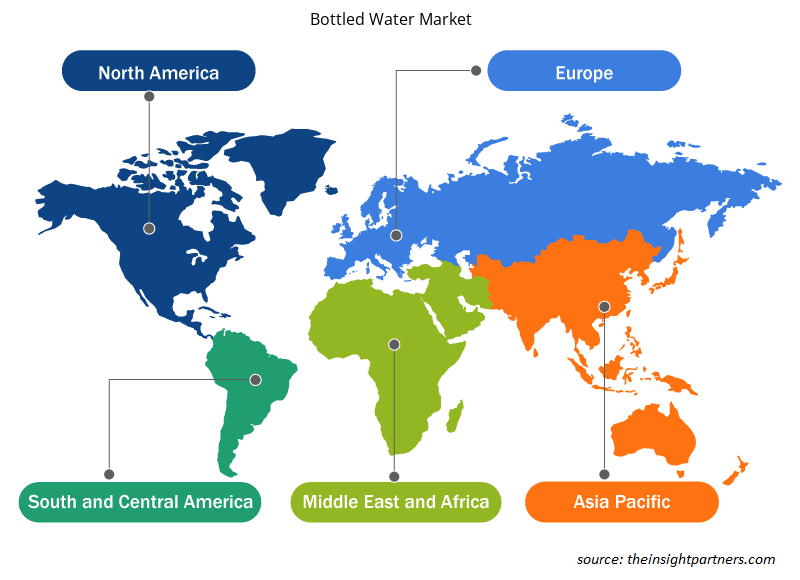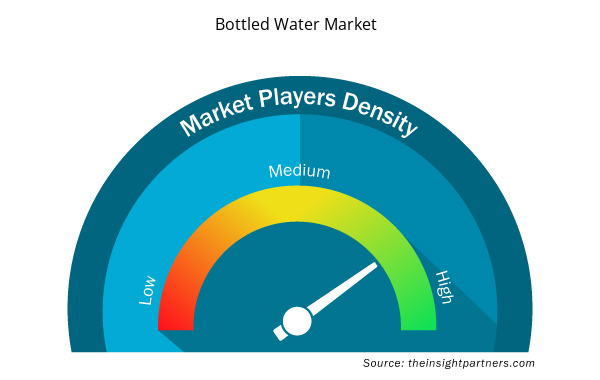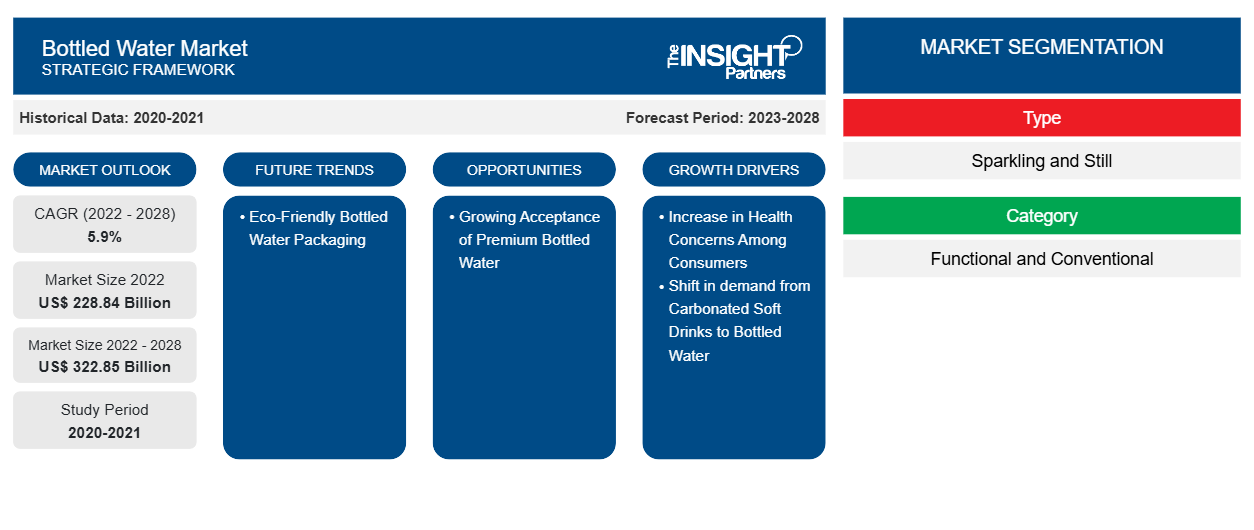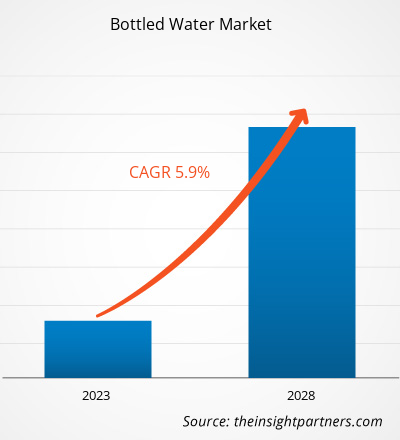[تقرير بحثي] من المتوقع أن ينمو سوق المياه المعبأة من 228.84 مليار دولار أمريكي في عام 2022 إلى 322.85 مليار دولار أمريكي بحلول عام 2028؛ ومن المتوقع أن ينمو بمعدل نمو سنوي مركب قدره 5.9٪ من عام 2022 إلى عام 2028.
رؤى السوق ووجهة نظر المحلل:
المياه المعبأة هي مياه شرب معبأة نقية وخالية من التلوث. المياه المعبأة هي في الغالب من نوعين: المياه الغازية/الفوارة أو المياه الساكنة، وهي متوفرة عمومًا في عبوات بلاستيكية أو زجاجية. المياه المعبأة هي الطريقة الأكثر ملاءمة لتلبية احتياجات الجسم من الترطيب، وبالتالي فهي متوفرة بسهولة في متاجر التجزئة القريبة وكذلك محلات السوبر ماركت والهايبر ماركت. إن المخاوف الصحية المتزايدة بين المستهلكين إلى جانب التحول في الطلب من المشروبات الغازية إلى المياه المعبأة تدفع نمو سوق المياه المعبأة في جميع أنحاء العالم. جنبًا إلى جنب مع هذا، فإن الزيادة في قبول المياه المعبأة الفاخرة توفر فرص نمو لسوق المياه المعبأة في جميع أنحاء العالم.
محركات النمو والتحديات:
أصبحت الصحة عاملاً مؤثراً بشكل متزايد في اختيار المستهلكين للمشروبات الغازية. تؤثر العديد من القضايا الصحية على ديناميكيات صناعة المشروبات الغازية . في الوقت الحاضر، يبحث المستهلكون عن بدائل أكثر صحة للمشروبات الغازية. إنهم يتحولون تدريجياً من الصودا إلى المياه المعبأة. يرجع هذا التحول بشكل أساسي إلى تغيير تفضيلات المستهلكين من المشروبات عالية السكر وغير الطبيعية إلى بدائل أكثر صحة. تعرضت المشروبات الغازية، وخاصة المشروبات الغازية، لانتقادات بسبب محتواها العالي من السكر. أدى الطلب المتزايد من المستهلكين على خيارات المشروبات الغازية الصحية إلى طلب كبير على المياه المعبأة. ساهم الاستهلاك المرتفع للمشروبات الغازية الغنية بالسكر في حدوث مشاكل مثل مشاكل الجهاز الهضمي وزيادة الوزن وحموضة المعدة. تركز شركات المياه المعبأة بشكل كبير على تقديم المياه المنكهة والوظيفية. هذه المنتجات مطلوبة بشدة بسبب المخاوف المتزايدة بشأن ارتفاع مستويات السمنة. يتحول المستهلكون بشكل متزايد نحو المياه المنكهة منخفضة السعرات الحرارية والمياه الوظيفية. وبالتالي، فإن التحول في الطلب من المشروبات الغازية إلى المياه المعبأة يقود بشكل أساسي سوق المياه المعبأة على مستوى العالم.
يتم شراء زجاجات المياه بكميات ضخمة كل عام. ومع ذلك، يتم إعادة تدوير كمية أقل بكثير. ينتهي المطاف بالعديد من زجاجات المياه البلاستيكية المشتراة في مكبات النفايات. وهذا يؤدي إلى مشكلة كبيرة، حيث لا تتحلل زجاجات المياه بيولوجيًا بل تتحلل ضوئيًا. وفقًا لشركة Valley Water، تستغرق الزجاجات المستخدمة لتعبئة المياه أكثر من 1000 عام للتحلل البيولوجي، وإذا تم حرقها، فإنها تنتج أبخرة سامة. تتسرب كل زجاجة مواد كيميائية ضارة إلى البيئة على طول الطريق أثناء تحللها. تتسرب السموم من زجاجات المياه المتحللة إلى البيئة وتسبب مشاكل صحية مختلفة مثل مشاكل الإنجاب والسرطان. علاوة على ذلك، وجدت الأبحاث التي أجراها معهد برشلونة للصحة العالمية (ISGlobal) أن تأثير المياه المعبأة على النظم البيئية أعلى بمقدار 1400 مرة من مياه الصنبور. وبالتالي، من المتوقع أن تعمل التأثيرات الضارة للمياه المعبأة على البيئة على كبح نمو سوق المياه المعبأة خلال فترة التنبؤ.
قم بتخصيص هذا التقرير ليناسب متطلباتك
ستحصل على تخصيص لأي تقرير - مجانًا - بما في ذلك أجزاء من هذا التقرير، أو تحليل على مستوى الدولة، وحزمة بيانات Excel، بالإضافة إلى الاستفادة من العروض والخصومات الرائعة للشركات الناشئة والجامعات
- احصل على أهم اتجاهات السوق الرئيسية لهذا التقرير.ستتضمن هذه العينة المجانية تحليلاً للبيانات، بدءًا من اتجاهات السوق وحتى التقديرات والتوقعات.
تقسيم التقرير ونطاقه:
يتم تقسيم "سوق المياه المعبأة العالمية" على أساس النوع والفئة والنكهة وقناة التوزيع والجغرافيا. بناءً على النوع، يتم تقسيم سوق المياه المعبأة إلى فوارة وساكنة. على أساس الفئة، يتم تقسيم السوق إلى وظيفية وتقليدية. بناءً على النكهة، يتم تقسيم سوق المياه المعبأة إلى عادية ومنكهة. بناءً على قناة التوزيع، يتم تقسيم سوق المياه المعبأة إلى محلات السوبر ماركت والهايبر ماركت ومتاجر التجزئة عبر الإنترنت وغيرها. يتم تقسيم سوق المياه المعبأة على أساس الجغرافيا إلى أمريكا الشمالية (الولايات المتحدة وكندا والمكسيك) وأوروبا (ألمانيا وفرنسا وإيطاليا والمملكة المتحدة وروسيا وبقية أوروبا) وآسيا والمحيط الهادئ (أستراليا والصين واليابان والهند وكوريا الجنوبية وبقية آسيا والمحيط الهادئ) والشرق الأوسط وأفريقيا (جنوب أفريقيا والمملكة العربية السعودية والإمارات العربية المتحدة وبقية الشرق الأوسط وأفريقيا) وأمريكا الجنوبية والوسطى (البرازيل والأرجنتين وبقية أمريكا الجنوبية والوسطى).
التحليل القطاعي:
بناءً على النوع، يتم تقسيم سوق المياه المعبأة إلى فوارة وساكنة. على أساس الفئة، يتم تقسيم السوق إلى وظيفية وتقليدية. بناءً على النكهة، يتم تقسيم سوق المياه المعبأة إلى عادية ومنكهة. بناءً على قناة التوزيع، يتم تقسيم سوق المياه المعبأة إلى محلات السوبر ماركت والهايبر ماركت ومتاجر التجزئة عبر الإنترنت وغيرها. احتلت الشريحة التقليدية حصة كبيرة في سوق المياه المعبأة ومن المتوقع أن تسجل نموًا كبيرًا خلال فترة التنبؤ. المياه المعبأة التقليدية هي مياه بدون أي مكونات مضافة. من المتوقع أن يؤدي زيادة وعي المستهلك بالقضايا الصحية المرتبطة بالمكونات المضافة المستخدمة في المياه المعبأة إلى زيادة اعتماد المياه المعبأة التقليدية. استخدام المياه المعبأة التقليدية أعلى بكثير في الأماكن التي تشكل فيها مياه الصنبور مصدر قلق. يتم الحصول عليها من مصادر المياه الطبيعية مثل الينابيع والخزانات الجوفية. إنها غنية بالعديد من المعادن الأساسية، بما في ذلك المغنيسيوم والكالسيوم والصوديوم. الفوائد الصحية المرتبطة بالمياه المعبأة التقليدية تزيد من الطلب عليها.
التحليل الإقليمي:
بناءً على الجغرافيا، ينقسم سوق المياه المعبأة إلى خمس مناطق رئيسية: أمريكا الشمالية وأوروبا وآسيا والمحيط الهادئ وأمريكا الجنوبية والوسطى والشرق الأوسط وأفريقيا. هيمنت منطقة آسيا والمحيط الهادئ على سوق المياه المعبأة العالمية والتي بلغت قيمتها 74.55 مليار دولار أمريكي في عام 2022. تعد أمريكا الشمالية ثاني أكبر مساهم بحصة تزيد عن 31٪ في السوق العالمية. ومن المتوقع أن تسجل أوروبا نموًا كبيرًا بمعدل نمو سنوي مركب قدره 5.5٪ خلال الفترة المتوقعة. يُعزى الطلب على المياه المعبأة في زجاجات في أمريكا الشمالية إلى الطلب المتزايد على مياه الشرب النظيفة والآمنة وعالية الجودة. وفقًا للرابطة الدولية للمياه المعبأة في زجاجات، تجاوز استهلاك الفرد في الولايات المتحدة 45.2 جالونًا في عام 2020. علاوة على ذلك، يفضل العديد من العملاء المياه المعبأة المنكهة. وقد أدى هذا إلى زيادة شركات المياه المعبأة في زجاجات لتقديم منتجات جديدة بمكونات نكهة وتغليف جذاب.
تطورات الصناعة والفرص المستقبلية:
فيما يلي قائمة بالمبادرات المختلفة التي اتخذها اللاعبون الرئيسيون العاملون في سوق المياه المعبأة في زجاجات:
- في مارس 2022، أعلنت شركة RHODIUS Mineralquellen عن تطوير زجاجات PET المصنوعة من 75% من PET المعاد تدويره. وكان الهدف من التطوير تقديم حل تغليف مستدام للمياه المعبأة.
- في فبراير 2021، طورت شركة كوكا كولا نوعين جديدين من المياه الغازية الخالية من السعرات الحرارية والصوديوم والمحليات. تتضمن النكهة التوت + الآساي والمانجو + الشاي الأسود.
- في يناير 2020، قدمت شركة VOSS النرويجية مياه Voss+ المعززة في زجاجات بلاستيكية معاد تدويرها بنسبة 100%. تتضمن مجموعة VOSS+ VOSS + Collagen وVOSS + Vitamin D وVOSS + Aquamin. وكان الهدف من الإطلاق تلبية الطلب المتزايد من المستهلكين على المنتجات المستدامة في المياه المعبأة.
رؤى إقليمية حول سوق المياه المعبأة
لقد قام المحللون في Insight Partners بشرح الاتجاهات والعوامل الإقليمية المؤثرة على سوق المياه المعبأة طوال فترة التوقعات بشكل شامل. يناقش هذا القسم أيضًا قطاعات سوق المياه المعبأة والجغرافيا في جميع أنحاء أمريكا الشمالية وأوروبا ومنطقة آسيا والمحيط الهادئ والشرق الأوسط وأفريقيا وأمريكا الجنوبية والوسطى.

- احصل على البيانات الإقليمية المحددة لسوق المياه المعبأة
نطاق تقرير سوق المياه المعبأة
| سمة التقرير | تفاصيل |
|---|---|
| حجم السوق في عام 2022 | 228.84 مليار دولار أمريكي |
| حجم السوق بحلول عام 2028 | 322.85 مليار دولار أمريكي |
| معدل النمو السنوي المركب العالمي (2022 - 2028) | 5.9% |
| البيانات التاريخية | 2020-2021 |
| فترة التنبؤ | 2023-2028 |
| القطاعات المغطاة | حسب النوع
|
| المناطق والدول المغطاة | أمريكا الشمالية
|
| قادة السوق وملفات تعريف الشركات الرئيسية |
|
كثافة اللاعبين في سوق المياه المعبأة: فهم تأثيرها على ديناميكيات الأعمال
يشهد سوق المياه المعبأة نموًا سريعًا، مدفوعًا بالطلب المتزايد من المستخدم النهائي بسبب عوامل مثل تفضيلات المستهلكين المتطورة والتقدم التكنولوجي والوعي المتزايد بفوائد المنتج. ومع ارتفاع الطلب، تعمل الشركات على توسيع عروضها والابتكار لتلبية احتياجات المستهلكين والاستفادة من الاتجاهات الناشئة، مما يؤدي إلى زيادة نمو السوق.
تشير كثافة اللاعبين في السوق إلى توزيع الشركات أو المؤسسات العاملة في سوق أو صناعة معينة. وهي تشير إلى عدد المنافسين (اللاعبين في السوق) الموجودين في مساحة سوق معينة نسبة إلى حجمها أو قيمتها السوقية الإجمالية.
الشركات الرئيسية العاملة في سوق المياه المعبأة هي:
- دانون إس إيه
- بلوتريتون براندز، المحدودة
- شركة مياه فيجي ذ.م.م.
- جيرولشتاينر برونين جي إم بي إتش آند كو
- شركة نستله السعودية
إخلاء المسؤولية : الشركات المذكورة أعلاه ليست مرتبة بأي ترتيب معين.

- احصل على نظرة عامة على أهم اللاعبين الرئيسيين في سوق المياه المعبأة
تأثير كوفيد-19:
أثرت جائحة كوفيد-19 على الاقتصادات والصناعات في مختلف البلدان بسبب عمليات الإغلاق وحظر السفر وإغلاق الشركات. عانت صناعة الأغذية والمشروبات بسبب الاضطرابات الخطيرة في سلاسل التوريد وإغلاق مصانع الإنتاج في المراحل الأولية من الوباء. أدى إغلاق مصانع التصنيع في الدول الرائدة في أمريكا الشمالية وأوروبا وآسيا والمحيط الهادئ وأمريكا الجنوبية والوسطى والشرق الأوسط وأفريقيا إلى اضطراب سلاسل التوريد العالمية والتصنيع وجداول التسليم ومبيعات السلع. علاوة على ذلك، أعلنت العديد من الشركات عن تأخيرات محتملة في تسليم المنتجات وانخفاض في مبيعات منتجاتها المستقبلية في عام 2020. بالإضافة إلى ذلك، أجبر الحظر الذي فرضته دول مختلفة في أوروبا وآسيا وأمريكا الشمالية على السفر الدولي الشركات على تعليق خطط التعاون والشراكة مؤقتًا
في عام 2020، اضطرت العديد من الصناعات إلى إبطاء عملياتها بسبب الاضطرابات في سلاسل القيمة الناجمة عن إغلاق الحدود الوطنية والدولية. بعد الإعلان عن عمليات الإغلاق، زاد الطلب على المياه المعبأة حيث سارعت الأسر إلى تأمين الإمدادات. أثناء الوباء، أدى الافتقار إلى الوصول إلى المياه الآمنة أو البنية التحتية الكافية، إلى جانب المخاوف الصحية، إلى زيادة مبيعات المياه المعبأة في جميع أنحاء العالم. من ناحية أخرى، مع إجبار السياح وموظفي المكاتب على البقاء في منازلهم، شهدت البلدان ذات الاقتصادات التي تركز على الخدمات انخفاضًا في مبيعات الزجاجات البلاستيكية. مع بدء الاقتصادات في إحياء عملياتها في عام 2021، يرتفع الطلب على المياه المعبأة على مستوى العالم. تعمل إعادة فتح الأنشطة التجارية في قطاع الضيافة والسياحة على خلق طلب على المياه المعبأة. ومن المتوقع أن يوفر الطلب المتزايد على المياه المعبأة المزيد من فرص النمو لسوق المياه المعبأة خلال فترة التنبؤ.
المنافسة والشركات الرئيسية:
تشمل بعض الشركات البارزة العاملة في سوق المياه المعبأة العالمية شركة دانون؛ وشركة فيجي ووتر المحدودة؛ وشركة جيرولستينر برونين المحدودة وشركاه؛ وشركة كوكاكولا؛ وشركة نستله؛ وشركة نونجفو سبرينج؛ وشركة بلوتريتون براندز؛ وشركة بيبسيكو المحدودة؛ وشركة فوس أوف نورواي؛ وشركة روديوس مينيرالكويلين آند جيترانكي المحدودة وشركاه من بين شركات أخرى. تقدم هذه الشركات المياه المعبأة بنكهات مختلفة وتقدم منتجاتها في حلول تغليف مستدامة لجذب عدد كبير من المستهلكين.
- التحليل التاريخي (سنتان)، السنة الأساسية، التوقعات (7 سنوات) مع معدل النمو السنوي المركب
- تحليل PEST و SWOT
- حجم السوق والقيمة / الحجم - عالميًا وإقليميًا وقطريًا
- الصناعة والمنافسة
- مجموعة بيانات Excel


- Constipation Treatment Market
- Small Satellite Market
- Electronic Health Record Market
- Hydrogen Compressors Market
- Fertilizer Additives Market
- Non-Emergency Medical Transportation Market
- Visualization and 3D Rendering Software Market
- Bioremediation Technology and Services Market
- Personality Assessment Solution Market
- Oxy-fuel Combustion Technology Market

Report Coverage
Revenue forecast, Company Analysis, Industry landscape, Growth factors, and Trends

Segment Covered
This text is related
to segments covered.

Regional Scope
North America, Europe, Asia Pacific, Middle East & Africa, South & Central America

Country Scope
This text is related
to country scope.
الأسئلة الشائعة
Concerns over growing obesity levels, along with increased public knowledge about health issues in nations such as China, India, and Indonesia, boosted the bottled water business. Consumers are shifting away from sugary carbonated beverages and toward healthier options. This shift contributed significantly to the expansion of bottled water.
In 2021, the plain segment held the largest market share. Easy availability of plain water in grocery stores, the safety of the water and the cost assisted the market growth in 2021.
In 2021, Asia Pacific accounted for the largest global bottled water market share. Bottled water is considered the most convenient form of water since it is available in a variety of suitable containers that make it easy for customers to transport. These water bottles are convenient for on-the-go use. Recovering tourism industry, rising health and wellness awareness among consumers, a lack of access to safe water, and consumer preference changed from water purifiers to bottled water in the Asia Pacific.
Based on material, the sparkling segment is expected to be the fastest-growing segment during the forecast period. People all across the world are increasingly changing to healthier and more innovative drinks, including sparkling water, as the trend of adopting a healthy lifestyle among all age groups increases. The market is expected to be driven by the increased customer preference for sparkling water over sodas and sugary carbonated drinks.
In 2021, the still segment held the largest market share. In 2021, still water was popular among consumers due to its positive health benefits, as still water is sourced from natural resources such as springs and public water supply. These factors assisted still water in maintaining its dominance in the type segment of the bottled water market in 2021.
The major players operating in the bottled water market are Danone S.A., Bluetriton Brands, Inc., Fiji Water Company LLC., Gerolsteiner Brunnen Gmbh And Co. Kg, Nestlé S.A., Nongfu Spring, PepsiCo, Inc., Rhodius Mineralquellen und Getränke GmbH & Co. KG, The Coca-Cola Company, and Voss of Norway AS.
The List of Companies - Bottled Water Market
- Danone S.A.
- Bluetriton Brands, Inc.
- Fiji Water Company LLC.
- Gerolsteiner Brunnen Gmbh And Co. Kg
- Nestlé S.A.
- Nongfu Spring
- PepsiCo, Inc.
- Rhodius Mineralquellen und Getränke GmbH & Co. KG
- The Coca-Cola Company
- Voss of Norway AS
The Insight Partners performs research in 4 major stages: Data Collection & Secondary Research, Primary Research, Data Analysis and Data Triangulation & Final Review.
- Data Collection and Secondary Research:
As a market research and consulting firm operating from a decade, we have published and advised several client across the globe. First step for any study will start with an assessment of currently available data and insights from existing reports. Further, historical and current market information is collected from Investor Presentations, Annual Reports, SEC Filings, etc., and other information related to company’s performance and market positioning are gathered from Paid Databases (Factiva, Hoovers, and Reuters) and various other publications available in public domain.
Several associations trade associates, technical forums, institutes, societies and organization are accessed to gain technical as well as market related insights through their publications such as research papers, blogs and press releases related to the studies are referred to get cues about the market. Further, white papers, journals, magazines, and other news articles published in last 3 years are scrutinized and analyzed to understand the current market trends.
- Primary Research:
The primarily interview analysis comprise of data obtained from industry participants interview and answers to survey questions gathered by in-house primary team.
For primary research, interviews are conducted with industry experts/CEOs/Marketing Managers/VPs/Subject Matter Experts from both demand and supply side to get a 360-degree view of the market. The primary team conducts several interviews based on the complexity of the markets to understand the various market trends and dynamics which makes research more credible and precise.
A typical research interview fulfils the following functions:
- Provides first-hand information on the market size, market trends, growth trends, competitive landscape, and outlook
- Validates and strengthens in-house secondary research findings
- Develops the analysis team’s expertise and market understanding
Primary research involves email interactions and telephone interviews for each market, category, segment, and sub-segment across geographies. The participants who typically take part in such a process include, but are not limited to:
- Industry participants: VPs, business development managers, market intelligence managers and national sales managers
- Outside experts: Valuation experts, research analysts and key opinion leaders specializing in the electronics and semiconductor industry.
Below is the breakup of our primary respondents by company, designation, and region:

Once we receive the confirmation from primary research sources or primary respondents, we finalize the base year market estimation and forecast the data as per the macroeconomic and microeconomic factors assessed during data collection.
- Data Analysis:
Once data is validated through both secondary as well as primary respondents, we finalize the market estimations by hypothesis formulation and factor analysis at regional and country level.
- Macro-Economic Factor Analysis:
We analyse macroeconomic indicators such the gross domestic product (GDP), increase in the demand for goods and services across industries, technological advancement, regional economic growth, governmental policies, the influence of COVID-19, PEST analysis, and other aspects. This analysis aids in setting benchmarks for various nations/regions and approximating market splits. Additionally, the general trend of the aforementioned components aid in determining the market's development possibilities.
- Country Level Data:
Various factors that are especially aligned to the country are taken into account to determine the market size for a certain area and country, including the presence of vendors, such as headquarters and offices, the country's GDP, demand patterns, and industry growth. To comprehend the market dynamics for the nation, a number of growth variables, inhibitors, application areas, and current market trends are researched. The aforementioned elements aid in determining the country's overall market's growth potential.
- Company Profile:
The “Table of Contents” is formulated by listing and analyzing more than 25 - 30 companies operating in the market ecosystem across geographies. However, we profile only 10 companies as a standard practice in our syndicate reports. These 10 companies comprise leading, emerging, and regional players. Nonetheless, our analysis is not restricted to the 10 listed companies, we also analyze other companies present in the market to develop a holistic view and understand the prevailing trends. The “Company Profiles” section in the report covers key facts, business description, products & services, financial information, SWOT analysis, and key developments. The financial information presented is extracted from the annual reports and official documents of the publicly listed companies. Upon collecting the information for the sections of respective companies, we verify them via various primary sources and then compile the data in respective company profiles. The company level information helps us in deriving the base number as well as in forecasting the market size.
- Developing Base Number:
Aggregation of sales statistics (2020-2022) and macro-economic factor, and other secondary and primary research insights are utilized to arrive at base number and related market shares for 2022. The data gaps are identified in this step and relevant market data is analyzed, collected from paid primary interviews or databases. On finalizing the base year market size, forecasts are developed on the basis of macro-economic, industry and market growth factors and company level analysis.
- Data Triangulation and Final Review:
The market findings and base year market size calculations are validated from supply as well as demand side. Demand side validations are based on macro-economic factor analysis and benchmarks for respective regions and countries. In case of supply side validations, revenues of major companies are estimated (in case not available) based on industry benchmark, approximate number of employees, product portfolio, and primary interviews revenues are gathered. Further revenue from target product/service segment is assessed to avoid overshooting of market statistics. In case of heavy deviations between supply and demand side values, all thes steps are repeated to achieve synchronization.
We follow an iterative model, wherein we share our research findings with Subject Matter Experts (SME’s) and Key Opinion Leaders (KOLs) until consensus view of the market is not formulated – this model negates any drastic deviation in the opinions of experts. Only validated and universally acceptable research findings are quoted in our reports.
We have important check points that we use to validate our research findings – which we call – data triangulation, where we validate the information, we generate from secondary sources with primary interviews and then we re-validate with our internal data bases and Subject matter experts. This comprehensive model enables us to deliver high quality, reliable data in shortest possible time.


 احصل على عينة مجانية لهذا التقرير
احصل على عينة مجانية لهذا التقرير